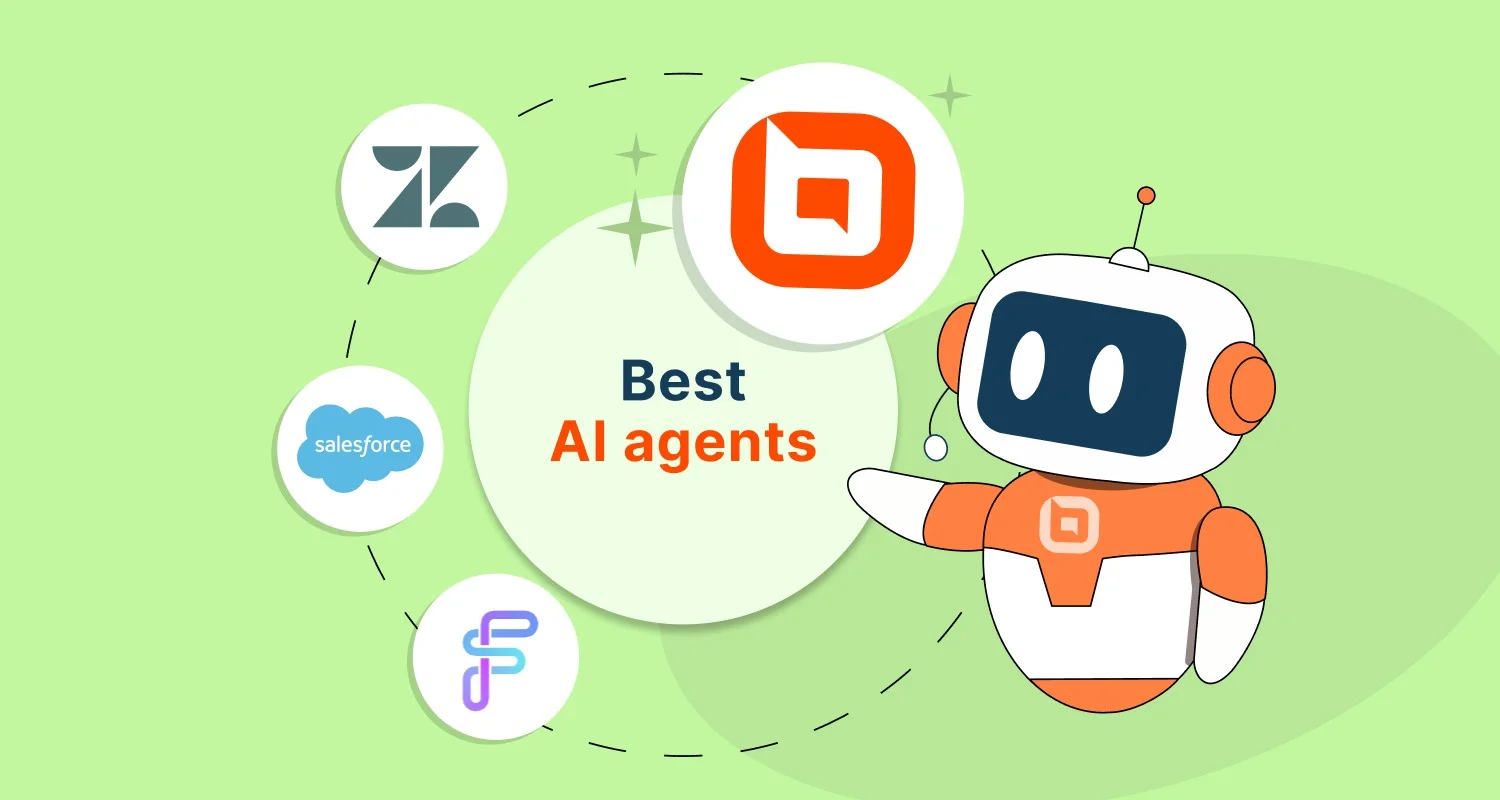We’ve all been there, trapped in a frustrating chatbot loop, shouting “agent!” at our screens. But customer support is evolving.
AI agents are no longer just glorified FAQ bots. They’re becoming autonomous, intelligent, and capable of transforming how businesses interact with customers.
Instead of relying on rigid scripts, modern AI agents learn from your help articles, FAQs, and website content. They connect to your tools to perform tasks like updating orders or resetting passwords, making them far more than just conversational interfaces.
So, how do you build AI agents that actually work for your business? Let’s break it down, step-by-step.
Why use AI agents for customer support?
Support teams often face an overwhelming volume of repetitive questions, which can drive up costs and lead to long wait times. Traditional chatbots were once a go to option, but their limited adaptability often caused more frustration than resolution.
AI agents offer a smarter solution. They:
- Deliver instant, accurate responses by understanding customer intent and accessing relevant knowledge.
- Automate routine tasks, reducing operational costs and freeing up human agents for complex, high-value interactions.
- Improve customer satisfaction through faster resolutions and more personalized support experiences.
By combining deep understanding with real-time action, AI agents help businesses scale support efficiently while maintaining quality.
7 Easy steps for building AI agents with BoldDesk
Creating a high-impact AI agent doesn’t require a PhD in machine learning. With the right AI agent builder, tools and strategy, anyone can build it.
Here is a simplified roadmap on how you can build an AI agent from scratch with BoldDesk, for high-impact support.
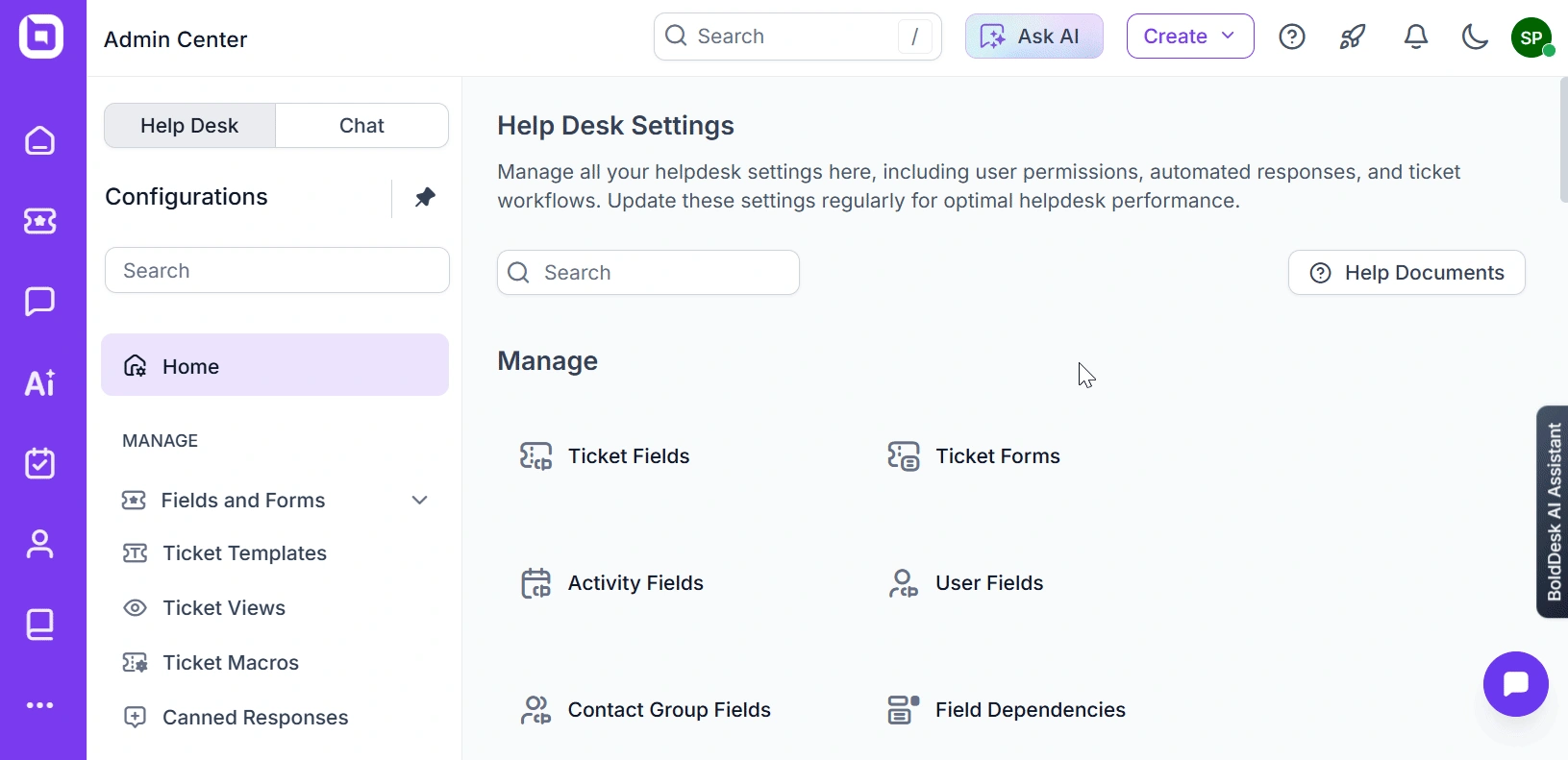
Step 1: Enable AI features
To start using AI tools in BoldDesk, go to the Admin settings and find the Artificial Intelligence section. There, you’ll see a list of AI features. Turn on the AI Agent feature to begin.
If you’d like extra help with tasks or want the system to suggest actions automatically, you can also enable AI Actions and AI Copilot.
Ensure your plan (Momentum or Enterprise) supports building AI agents.
Step 2: Create a new AI Agent
To get started, go to the AI module and look for the option to Create Agent. You’ll be asked to give your agent a name (something descriptive like Billing Agent or Support Assistant works well).
After naming it, you’ll choose which brand the agent belongs to and select the channels it will use, such as the web widget, live chat, email, or WhatsApp.
Next, define what your agent should do. This means setting up the logic or the types of questions and topics (called intents) the agent will respond to. For example, you might want it to handle billing inquiries, password resets, or order tracking.
BoldDesk doesn’t dive into every single field, but once you log in, the interface is intuitive and easy to navigate. Here’s how you can quickly get started with the AI-powered agent.
Step 3: Configure knowledge base and training
Assign the data sources the AI agent will use: FAQs, KB articles, PDFs, URLs. BoldDesk refers to “Data Sources & Limits”.
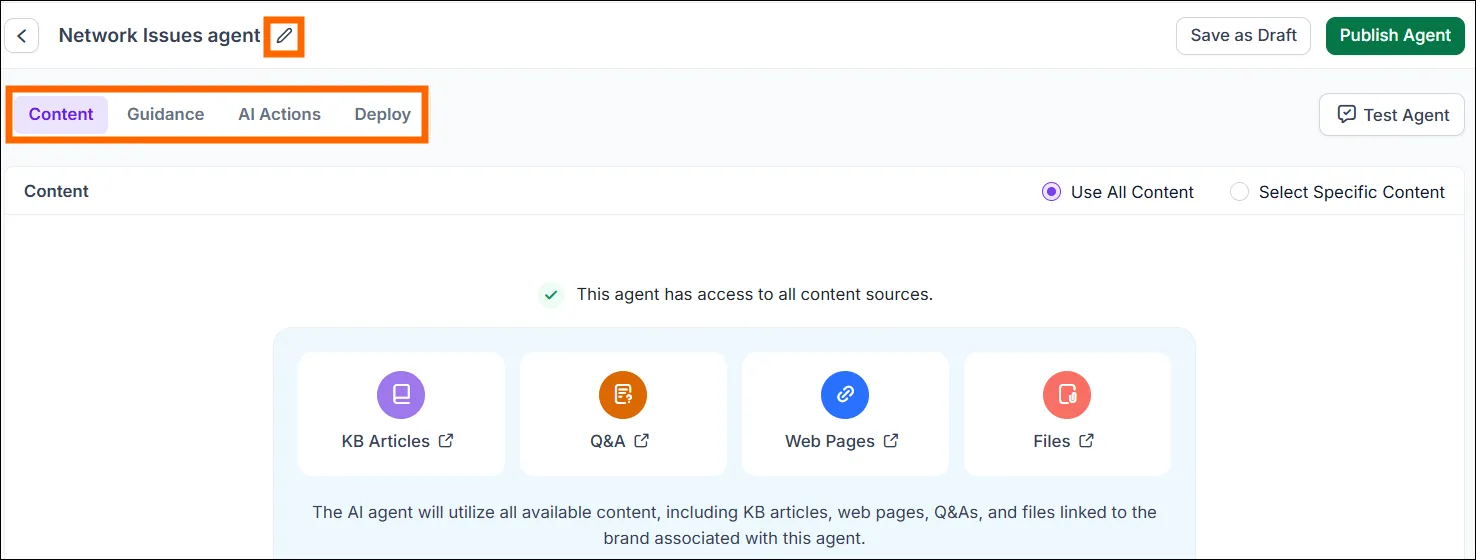
- Add custom intents or phrases if needed (for domain-specific tasks).
- Set fallback behavior: if the agent cannot confidently answer, it should escalate to human.
- Define tone, brand voice, language settings. When building ai agents, getting the personality right is key.
- If the agent will perform actions (via API) then ensure those actions are configured (see next section).
Step 4: Configure AI Actions (for backend tasks)
If you want to build an AI customer service agent that is truly autonomous agent, you’ll want AI Actions. Here’s how:
To make your AI customer service agent more than just a chatbot, you can add AI Actions. They let the AI agent perform real tasks like updating records or sending confirmations.
- Go to the AI Actions section in Admin and click Create Action.
- Choose the type (API or MCP Server), then set a trigger. This can either be from the AI Agent or AI Copilot.
- You’ll define what data to collect (like order ID or email), connect to your system using an API endpoint, and map the response so the agent knows what to say back.
- Test the API response in the sandbox, then publish the action.
Now, when a customer says something like “Cancel my subscription”, the agent can take action instantly, turning a simple chat into real automation.
Step 5: Map the agent to a channel/widget
To make your AI Agent available to customers, you need to connect it to the right communication channels. This ensures it responds in context and automates replies effectively.
The supported channels include live chat, web widgets, social platforms like WhatsApp, Instagram, Facebook and messaging services such as Twilio, Telegram, Gupshup WhatsApp, and Line.
For website integration:
- Go to the Admin settings, open Web Widgets & AI Agent, and click Add Widget.
- Select the AI Agent you created.
- Embed the provided JavaScript snippet into your website or customer portal.
You can also effortlessly automate live chat responses and deliver instant support using our AI-powered help desk software.
For other channels (e.g., WhatsApp, Telegram, Facebook): Set up the appropriate webhook or integration so the AI Agent can receive and respond to incoming messages.
Step 6: Quality testing before deployment to live
Before deploying your AI Agent, it’s essential to test its performance to ensure it responds accurately and handles tasks as expected. BoldDesk provides a built-in Test Agent interface to help with this.
To test the AI agent you have built:
- Use BoldDesk’s Test Agent feature in the AI module to simulate conversations.
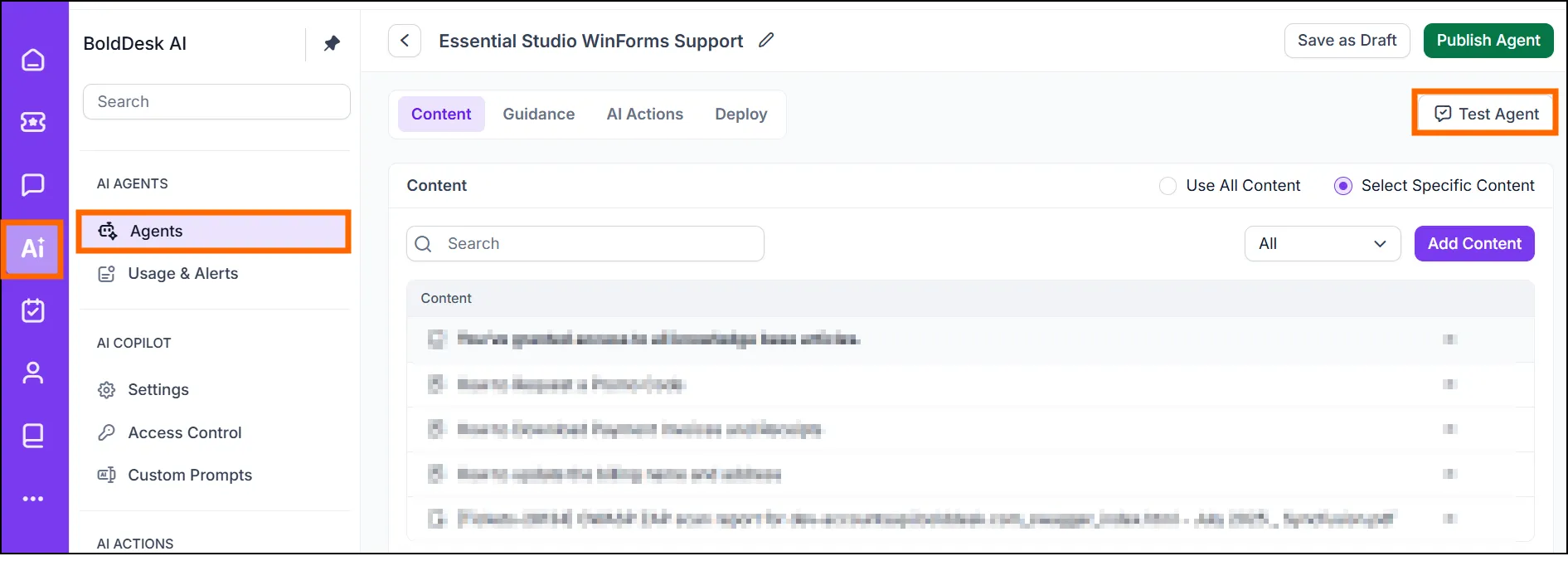
- Enter sample questions on different topics and intents, and see how the AI agent responds. Does it understand the topic? Give the right answer? Trigger the right AI action (if applicable)?
If you’ve created multiple agents for different roles (e.g., billing vs. technical support), test each one separately. Make sure queries are routed to the right agent. For example, a “technical issue” should go to the technical agent, not the billing agent.
Note any mistakes or misrouted responses, refine the training data or logic, and retest until the agent performs reliably. Thorough testing ensures a smooth experience when your AI Agent goes live.
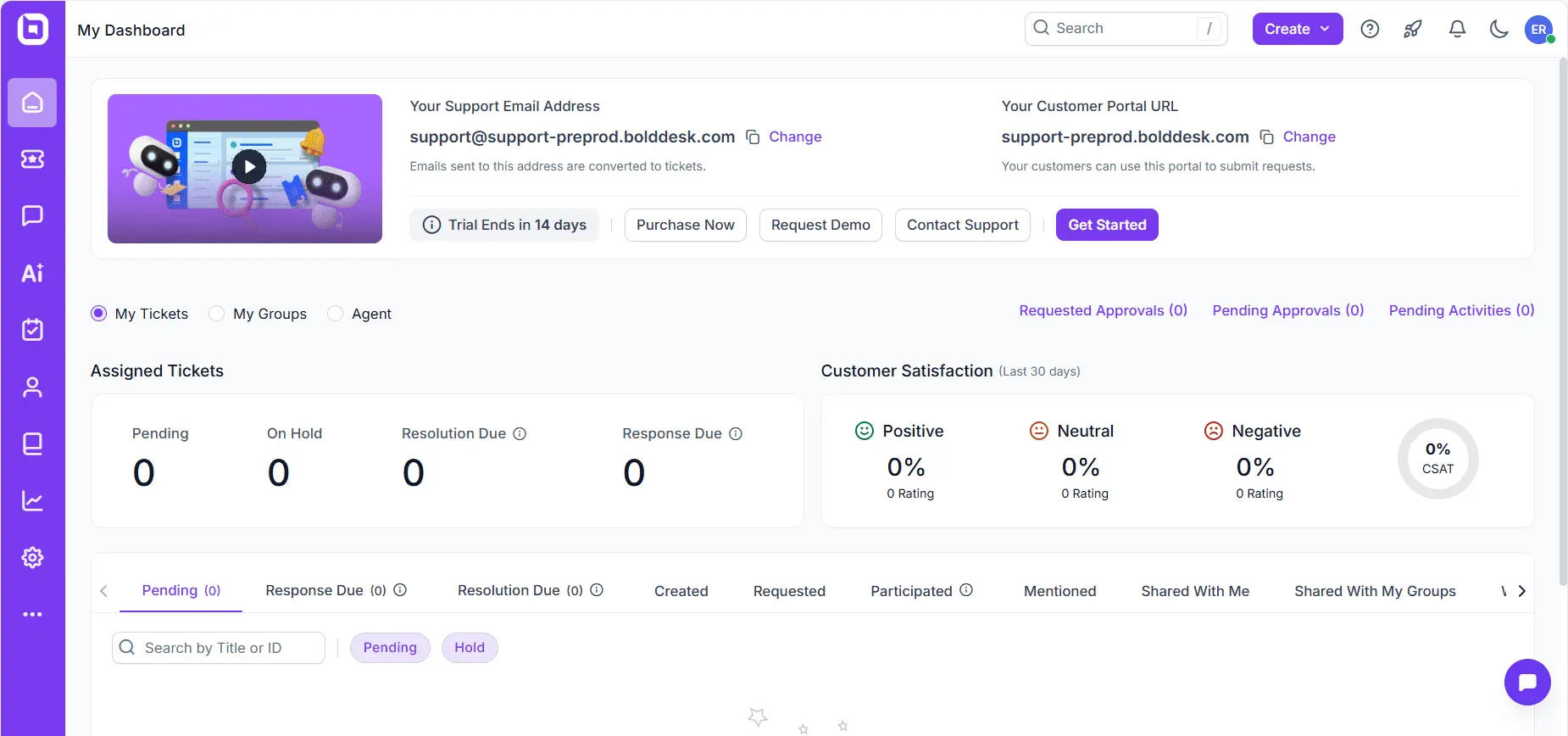
Step 7: Deployment to production
Once satisfied, publish the AI agent. Monitor closely in the first days:
- Check how many conversations were handled by the AI Agent vs those that were escalated.
- Monitor agent performance dashboard for errors or misclassifications.
- Set escalation rules: If the new AI agent fails, assign to human agent, send an apology e.g. “I’m transferring you to human”.
How to create and manage multiple AI agents
Sometimes you might need to build AI agents at scale and managing them effectively is key. To build multiple AI agents in BoldDesk, follow these steps to optimize customer support and business operations:
- Create AI Agents and assign roles: Set up multiple AI agents tailored to specific business functions such as billing, technical support, or onboarding. Customize each agent with unique content sources, tone, language, behavior settings, intent handling, and task execution logic.
- Map the AI Agents to channels: Assign each AI agent to specific communication channels like live chat, web widgets, or social media platforms to ensure contextual relevance to customer queries.
- Set permissions: Ensure you have the required permissions under admin roles, specifically ‘Manage AI Agents/Manage AI Actions,’ to manage AI agents effectively.
- Test AI multi-agents: Conduct quality assurance testing through simulation and refinement to ensure the multiple agents perform as expected.
- Edit, train and customize: Modify and customize each AI agent as needed. Use the ‘Deploy,’ ‘Publish,’ and ‘Save as Draft’ options to manage each agent’s operational status.
- Monitor performance: Track volume, resolution rate, response time, and customer satisfaction per agent to gauge how each is performing well.
- Delete AI Agents: If necessary, delete AI agents while ensuring operational efficiency, data retention, and reassignment of tasks to other agents.
Post-launch optimization and continuous improvement of AI agents
Building AI agents doesn’t stop after deployment. Here’s how to keep your AI agents productive and trusted.
- Closing feedback loops: Collect user feedback and review failed interactions to refine intents and actions.
- Knowledge base hygiene: Keep KB articles updated, use AI tools to enhance content, and tag by domain for relevance.
- Performance monitoring: Use dashboards to track resolution rates, response times, satisfaction, and escalation trends.
- Escalation handling: Ensure agents escalate when unsure, monitor for errors, and uphold security standards.
- Scaling strategy: Clone agents for new regions/products, maintain consistent training, and assign clear ownership.
Building AI agents that shape the customer service future
Building AI agents isn’t just a tech upgrade but also a strategic move. The right AI agent builder, like BoldDesk, makes it easy to create, deploy, and scale AI customer service agents without writing thousands of lines of code.
Whether you’re a startup founder, support manager, or developer, our platform helps you deliver smarter support.
Contact our support team to discover how you can customize and implement autonomous agents into your everyday workflow.
You can also try it out for a 15-day free trial:
✅ Cancel anytime, no contracts
✅ No credit card required
Related articles
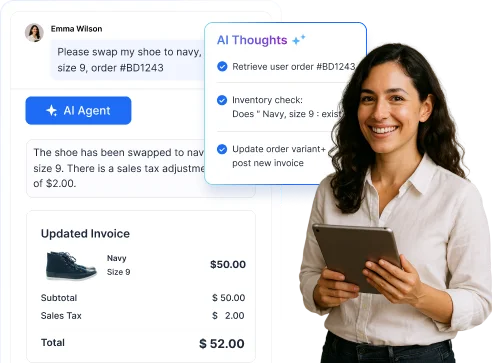


















 Email Ticketing System
Email Ticketing System Shared Inbox Software
Shared Inbox Software Multi Brand Help Desk
Multi Brand Help Desk Internal Help Desk Software
Internal Help Desk Software Trouble Ticketing Software
Trouble Ticketing Software Mobile Help Desk
Mobile Help Desk 











